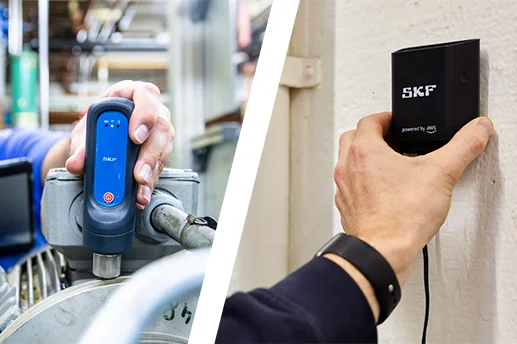What’s the difference between the SKF Axios System and SKF QuickCollect?

Choosing the right condition monitoring system doesn’t have to be a challenge. When it comes to wireless solutions, SKF Axios and the plug-and-play SKF QuickCollect sensors are two excellent options. Each system has its own advantages, so it’s important to know which one best fits your needs.
In this article, we’ll explain the key differences between these two systems and highlight their benefits so you can make an informed, confident choice.
SKF QuickCollect
Starting with the SKF QuickCollect sensor, this entry-level, plug-and-play system is designed for easy, one-off readings across multiple machine areas. It measures key parameters like velocity, acceleration, and temperature, allowing users to set machine-specific thresholds and generate actionable maintenance insights.
The magnetic sensor is ideal for walk-around data collection programs, enabling flexible use across different assets. When an alert signals a potential issue, users can instantly share data with SKF experts for analysis and guidance.
The SKF Plug and Play package includes:
- The SKF QuickCollect sensor
- The downloadable SKF Pulse app
- 24 free pulse checks by experts
- Access to SKF’s e-learning platform
This integrated system is designed for simplicity, so no specialist training is needed. Just connect the sensor, launch the app, and instantly view the condition of your machine components.
Check out the SKF QuickCollect kit here
SKF Axios
If QuickCollect is your starting point, SKF Axios is the next step. It’s a more scalable solution designed for longer-term use across multiple measurement points. While it needs a little more setup than QuickCollect, it’s still an entry-level system - built to be simple, straightforward, and easy to get to grips with.
Axios includes an intuitive app that works on a PC, tablet, or smartphone, giving you a clear view of your machine data wherever you are. You can track multiple sites and assets, spot trends, receive alerts, and give feedback to help fine-tune future notifications. It’s a smart way to stay ahead of issues and a solid move towards more advanced condition monitoring.
Both systems are designed to make predictive maintenance more accessible. Start small with QuickCollect or scale up with Axios. Either way, you’re taking control of machine health and stepping into a more proactive way of working, backed by tools that make it easier.
Check out the SKF Axios system here
Conclusion
QuickCollect and Axios are both excellent solutions, but each serves a different need. QuickCollect is perfect for those just starting out with predictive maintenance. It’s ideal for quick, one-off checks in various machine areas, with a focus on simplicity and ease of use. It’s perfect for small-scale applications or as part of a walk-around data collection program. On the other hand, Axios is a more scalable option, built for long-term use across multiple measurement points on larger, more complex machinery. While it requires more setup, it offers deeper insights with trend tracking, alert management, and the flexibility to monitor multiple sites and assets. Both systems are designed to make predictive maintenance easy, but QuickCollect is best for quick, flexible checks, while Axios is suited for organisations ready to scale up their condition monitoring efforts.
If you’re unsure, talk to our Bearing Expert, Andy Fletcher, who can help you set up the best condition monitoring system to suit your needs.
